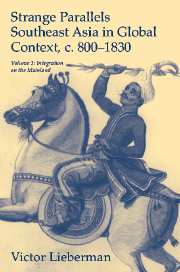Book contents
- Frontmatter
- Contents
- List of Figures
- Principal Political Eras on the Mainland
- Abbreviations Used in the Notes
- Preface
- 1 Introduction: The Ends of the Earth
- 2 One Basin, Two Poles: The Western Mainland and the Formation of Burma
- 3 A Stable, Maritime Consolidation: The Central Mainland
- 4 “The Least Coherent Territory in the World”: Vietnam and the Eastern Mainland
- Conclusion and Prologue
- Index
2 - One Basin, Two Poles: The Western Mainland and the Formation of Burma
Published online by Cambridge University Press: 06 January 2010
- Frontmatter
- Contents
- List of Figures
- Principal Political Eras on the Mainland
- Abbreviations Used in the Notes
- Preface
- 1 Introduction: The Ends of the Earth
- 2 One Basin, Two Poles: The Western Mainland and the Formation of Burma
- 3 A Stable, Maritime Consolidation: The Central Mainland
- 4 “The Least Coherent Territory in the World”: Vietnam and the Eastern Mainland
- Conclusion and Prologue
- Index
Summary
Our detailed examination of mainland history begins with the western sector of the mainland in part because it is convenient to proceed west to east and in part because here I am best able to address regional conundrums with indigenous-language primary sources. Moreover, insofar as any sector can be representative of so varied a region, the western mainland has a good claim. In duration and degree, for example, post-charter disruptions were intermediate between those of the central and eastern mainland. The same may be said of intrasectoral tensions: Upper Burma reemerged as the dominant zone within the western mainland in the 1630s. This was long after Ayudhya had established its preeminence in the central mainland, but almost 170 years before Hue gained a secure authority along the yet more fragmented eastern littoral.
As elsewhere, political change had a cyclic character: periodic breakdowns encouraged administrative reform, but reformed administrations collapsed before destabilizing economic growth, external attacks, and domestic factionalism. Whenever the capital region was in trouble, restive provinces were quick to magnify its difficulties. Thus Lower Burma exploited Upper Burma's problems in the 1280s and 1740s, and when the south faltered in the late 1500s, Upper Burma returned the favor. With the interior home to Burmans and the south to Mons, endemic north–south tensions had an irreducible, if fluid, ethnic component.
- Type
- Chapter
- Information
- Strange ParallelsSoutheast Asia in Global Context, c.800–1830, pp. 85 - 211Publisher: Cambridge University PressPrint publication year: 2003



